Life is unpredictable, and dire situations can arise at any given point. A company’s leave policy includes casual leaves to support an employee during such unforeseen circumstances. The employer grants casual leave as paid time off that employees can use in unexpected situations. The title hinted that the blog will discuss one needing to know all about casual leave applications, including the meaning, different types of casual leave application formats, as well as samples.
Usually, employees use casual leave to tend to personal matters where they might need a day or two off from work. Let’s understand through the blog everything about casual leaves: what they are, how you can add casual leaves to your company policies, why they are important, and much more.
What is a Casual Leave?
Casual leave (CL), is a paid leave assigned to employees from the company. CL allows employees to take short breaks from work for personal reasons or unexpected situations. Casual leaves are way different from sick or vacation leave. Casual leave is typically taken with little advance notice, offering employees the flexibility to handle sudden events, personal matters, or simply take a quick break when needed.
Key Features of Casual Application:
- Casual leave is usually pre-approved unless in case of emergency.
- As per the company’s policy, casual leaves are limited in number per year.
- CLs are not carried forward to the next year.
What is a Casual Leave Application?
A casual leave application ensures that employees are able to manage their personal lives without having to dip into their annual holiday or sick leave entitlements, promoting a healthy balance between work and life.
Below is a simple format to follow:
- Name and address of the sender
- Date of submitting the application
- Subject
- Name of the recipient
- Greetings
- Letter body (include reason and specific date)
- Closing Statement
- Ending with sender’s name and designation
How to Write a Casual Leave Application for Office?
A casual leave application is a formal way to seek permission for a short break from work due to personal reasons or unforeseen events. By drafting a clear and respectful application, you ensure that your request is processed smoothly. Given below are some of the significant elements to consider when mailing a casual leave application to your senior.
Elements the Casual Leave Application for Office?
Drafting a casual leave application for your office seniors allows you to request time off from work for personal matters, so it is important to keep in mind a few pointers that don’t seem unprofessional and unclear. A well-structured leave application should include the following key elements:
- Purpose of the Application: A casual leave is for employees to take time off for personal matters or unavoidable situations. CL is not the same as sick leave or vacation leave. So while writing a casual leave, mention your purpose so that it doesn’t seem false.
- Inform Your Employer: If the employee has to avail his or her casual leave, it is important to seek permission or inform your senior in advance and follow the procedure or guidelines they have for requesting leave.
- Greeting: Begin your mail with polite and professional greetings, addressing the relevant authority, such as “Dear/Good Morning (Supervisor/Manager/HR Manager).”
- State Your Purpose: While drafting the casual leave, it is important to clearly state your purpose for writing, specifying the dates you plan to be absent and the reason for your leave.
- Express Gratitude: Ending the mail with ‘Thank You’ for considering your request. Remember to reassure your senior that you will complete any pending work or delegate tasks during your absence.
- Provide Necessary Details: Provide the necessary details, such as your contact information or alternative arrangements if needed.
- Polite Closing Statement: Close with a polite statement, like “Thank you for your understanding and approval in advance.”
- Formal Closing: Finish with a formal closing, such as “Sincerely” or “Yours faithfully,” followed by your name and signature.
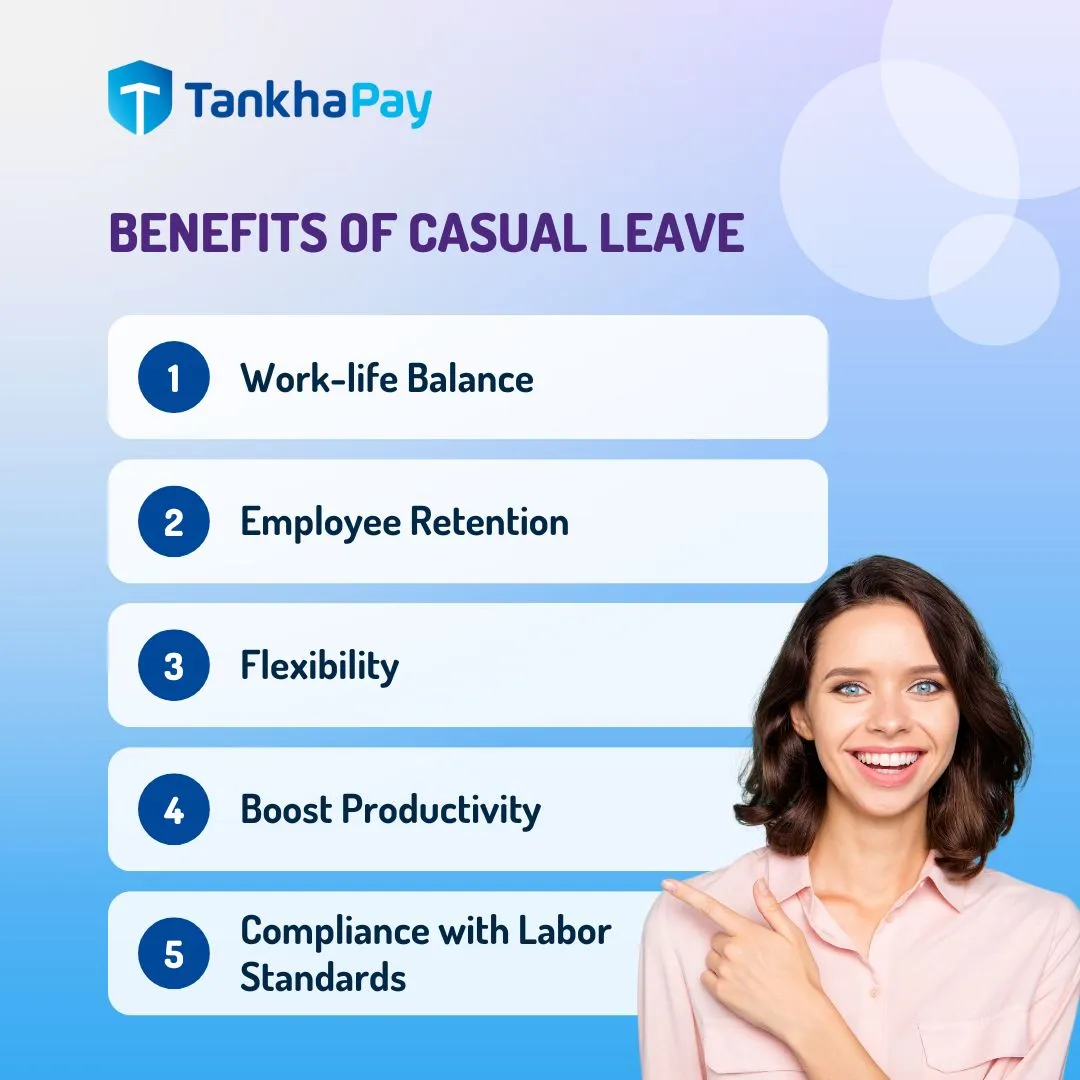
Casual Leave Application: Format and Samples
There are several reasons that an employee avails a casual leave application, such as a medical emergency, personal reasons, family, a close relation’s wedding to attend, festivals, a prior appointment, or others. Regardless of the reason, it is essential to communicate the request professionally and clearly to ensure a smooth approval process.
As you scroll, you’ll read some samples that will help you draft an effective leave application. We will outline the standard format and provide sample templates for different situations.
Casual Leave Application Format for Office
Below is a sample casual leave application that can be adapted to suit your needs.
HR Manager
AKAL Info
Subject: Casual Leave Application
Dear Amrita,
I hope this message finds you in good health. I am writing to request a casual leave for five days, starting from the 21st of November to the 25th of the same month, due to a family medical emergency. During my absence, I have arranged for Jordan Hnialum to handle my duties, and he has kindly agreed to take over my responsibilities. I trust he will manage the tasks diligently.
I will be available to resume work on the 27th of November. I kindly request your approval for this leave, and I assure you that I will ensure a smooth transition of my responsibilities before my departure.
Please feel free to contact me at 98******90 if any urgent matters require my attention during my absence.
Thank you for your understanding and support.
Warm regards,
Gargi Arora
Graphic Designer
Digital Marketing Team
Akal Info
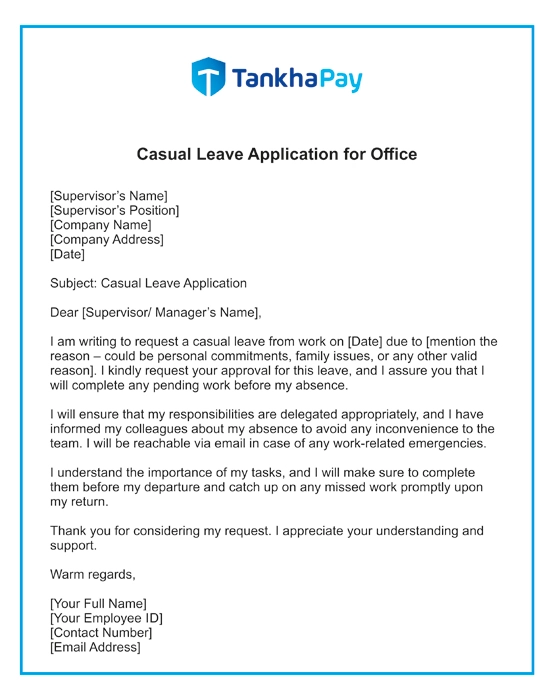
Casual Leave Application for Teachers
Teachers may occasionally need to take this leave for personal or medical reasons. Here is a sample casual leave application for teachers:
Subject: Casual Leave Application
Respected [Principal’s Name],
I hope you are doing well. I am writing to inform you that I need to take casual leave for [one/two] day(s) on [Insert Date(s)] due to [mention the reason briefly, e.g., personal emergency, health issues, etc.]. I will ensure that my lessons are covered during my absence.
I kindly request you to grant me leave for the mentioned period.
Thank you for your time and understanding.
Sincerely,
[Your Name]
[Your Subject]
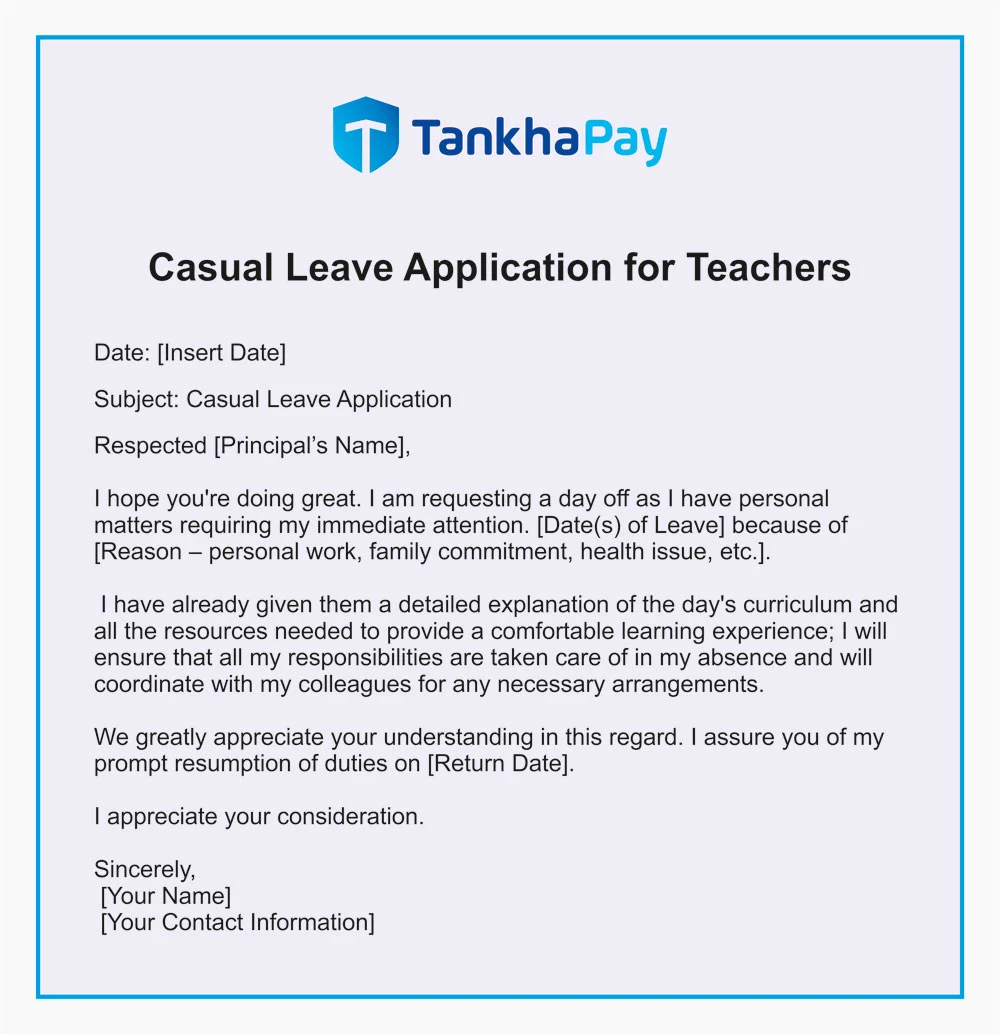
Read also for – Leave Application for Office
Casual Leave Application Sample for Medical Emergency
Dear [Manager’s Name],
I am writing this mail to request that I have a leave from (start date) to (end-date). I have to attend to a medical emergency for a close relative. As my relative lives in Bhopal ( Madhya Pradesh), I will have to visit my relative at his home, so I will have to ( mention days you have been on leave ). I will return to the workplace and resume work from (mention day).
Please feel free to contact me if any problem arises regarding my work. I shall be available on mobile and by email during the period. My fellow team members will handle my tasks while I am on leave.
I will be incredibly thankful to you for considering my application.
Yours Sincerely,
{Your Name}
Casual Leave Application Sample for Personal Reasons
Below is a sample application for casual leave due to personal reasons.
Good Morning Sir/Ma’am,
I hope this mail finds you well. I am writing this email as would have availed my casual leave on [Date] to attend the parent-teacher meeting of my child. The meeting will supposedly almost take a day. I will make sure that no work will get disturbed or will be pending.
Kindly consider and approve my leave. Please let me know if any additional information is required.
Thank you in advance.
Best regards,
[Your Name]
[Your Designation]
[Your Company Name]
Casual Leave Application Sample for Family Reasons
Below is a sample application for casual leave due to family reasons.
Dear Sir/Ma’am [Manager’s Name],
I hope this mail finds you well. I am writing this letter to kindly approve my casual leave from (number of days) i.e., [start date] to [end date]. I have to visit my home town to attend my cousin’s wedding . It would require me to travel. I will make sure that all my work is managed prior to avoiding any disturbances at work.
I will be available on calls and mails if anything comes up related to my work. I appreciate your understanding and look forward to your approval.
Thank you in advance.
Best regards,
[Your Name]
[Your Designation]
[Your Company Name]
Casual Leave Application for Sister’s Wedding
Below is a sample leave application for your sister’s wedding.
Dear/Good Morning [Senior’s Name],
I hope this mail finds you well. I am writing this email as would have availed my casual leaves for (number of days) i.e., [Start Date] to [End Date]. I have to visit my home town to attend and be a part of my sister’s wedding. This is a very important family function which is unavoidable. Kindly approve my leave application as my presence is important for various functions and preparations.
I will make sure that all my works are completed in advance, and I am happy to assist with any handovers before my leave. I will resume work from [mention date]. I appreciate your understanding and look forward to your approval.
Thank you in advance.
Yours Sincerely,
[Your Name]
[Your Designation]
Casual Leave Application for Appointment
Below is a sample application for casual leave due to an appointment.
Dear Sir/Ma’am [Supervisor Name],
I hope you are doing well. As you know that I have earlier injured my leg which required days to heal. And for that I would like to request for a casual leave on [Date] as I have an important medical appointment to check the healing that requires my presence. I will positively provide my appointment slip.
I will make sure that all my work is managed before my leave to avoid any disturbance.
Please let me know if you need any further details. I appreciate your understanding and look forward to your approval.
Best regards,
[Your Name]
[Your Designation]
[Your Company Name]
Casual Leave Application for Festival
Below is a sample application for requesting leave for a festival.
Dear Sir/Ma’am [Manager’s Name],
I would like to request you to approve my casual leave for (number of days) i.e., [start date] to [end date] to celebrate Chhath Puja with my family. This festival holds great significance for me as my mother fasts on this occasion. My presence is important for the puja, and I would appreciate your approval for my leave request.
I will make sure that all my work is finished in advance in order to avoid disturbances. Please let me know if you require any further information.
Thank you for your consideration. Looking forward to your approval.
Best regards,
[Your Name]
[Your Designation]
[Your Company Name]
What is a Casual Leave Policy?
Every organization or company has certain rules, regulations and policies for employees, which are supposed to be followed by each employee. Same to avail a casual leave, an employee has to follow certain rules. A casual leave policy states about the guideline and procedure to use a CL, the policy defines the criteria for who is eligible to take leave, the allowable duration for such leave, and the process for both applying and securing approval. The policy also details any necessary documentation that may be required, such as medical certificates or other supporting evidence, particularly in the case of unforeseen emergencies.
An effectively communicated and formatted casual leave policy ensures that employees avail CL fairly without any disruption in work. Also the policy may set a limit on taking casual leave during peak periods or important projects. Along with this, the CL policy helps in preventing the misuse outlining the consequences of unauthorized absences or excessive leave requests.
Clear rules help maintain fairness and consistency in managing time off. They ensure both employees and management understand their responsibilities, making sure casual leave is used properly and follows company policies.
Rules before Applying for a Casual Leave
When applying for casual leave, it’s important to plan ahead to avoid any issues. Keeping these key points in mind will help ensure a smooth process:
- Leave Balance: It is important to check your current leave balance before submitting a request to avail casual leave. Casual leaves given to every employee are in certain numbers and if the numbers are exceeded it could result in salary deductions. By staying aware of your remaining days, you can plan your absences accordingly and avoid any unpleasant surprises in your payslip.
- Nature of Leave: While requesting for casual leave, it is important to understand the reason to avail it. As stated above, CL are limited in number and so if the need for leave is not urgent employees must consider reserving it for urgent matters. It is designed to provide flexibility, but using it wisely ensures that it’s available when you truly need it.
- Documentation (if required): If availing the casual leaves for medical emergencies employees may be asked to provide documents like medical certificate or the appointment slip. It’s also advisable to give prior notice if possible, particularly if your casual leave is planned. Providing sufficient notice not only demonstrates responsibility but also ensures smoother approval from your supervisor.
- Leave Provision: It is highly recommended to the employees to read the company’s leave policy. Some organisations may have a “sandwich leave” rule, where weekends or holidays falling between casual leave days are also counted as leave. Understanding the maximum number of casual leave days you can take, as well as any policies regarding extended or consecutive leave, can help you avoid deductions and maintain a positive standing within the company.
- Work Calendar: As casual leaves can be availed in cases of urgencies, still it is advisable to review your work calendar. You need to ensure that your absence won’t disturb ongoing projects, important meetings, or deadlines. Proper planning will not only prevent your work from being negatively impacted but will also allow your team to make any necessary arrangements in your absence.
- Accumulation and Expiry: Know your company’s rules on casual leave—some allow carry forward, while others follow a ‘use it or lose it’ policy. Checking in advance helps you avoid losing leave days or facing deductions.
- Communication: Clear communication is key when applying for casual leave. Be sure to inform your employer or supervisor about the duration of your leave and the reason for your absence. Transparent communication helps avoid misunderstandings and ensures that your leave is approved without any issues. It also gives your team time to plan around your absence, minimising any potential disruptions to work.
Casual Leave vs. Earned Leave
Individuals who usually are beginners in the professional world, get confused between terms coined ‘casual leave’ and ‘earned leave’. The paragraph will clear all the blurry clouds regarding casual leave vs earned leave.
The difference between casual and earned leave primarily lies in their purpose, planning, and usage. Casual leave is generally unplanned and taken for short durations due to unforeseen circumstances, such as personal emergencies or urgent needs. It allows employees to address immediate concerns with minimal notice. On the other hand, earned leave is accumulated over time and typically planned well in advance, often for longer breaks, such as vacations or rest periods.
Casual leaves are usually approved immediately as they are used for short term and the need is something urgent or unavoidable. Meanwhile, earned leaves require advanced approval and are well planned. Also while the employee is using the earned leaves they must make sure that they are aligned according to work schedule and business needs. No work should be disrupted due to EL.
Although it is very important to manage these leaves over time. Earned leave grows over the period of time as employees work and can often be carried forward to the next year. It provides a greater flexibility in planning extended time off. Casual leave, however, is typically set on an annual basis and cannot be carried over, meaning any unused casual leave at the end of the year may be forfeited.
The primary purpose of casual leave is to meet the short-term urgent needs such as personal situations or medical emergencies. And in contrast, earned leaves offer extended breaks for employees to recharge and relax, often planned around holidays or significant time off.
FAQs
What is the difference between earned leave and casual leave?
The primary difference between casual leave and earned leave lies in their purpose and duration. Casual leave is typically taken for short durations and can be availed for as little as half a day, but it is generally limited to a maximum of three consecutive days. Any leave taken beyond that period usually falls under earned leave, which is accumulated over time. Earned leave is often planned in advance, while casual leave is used for unforeseen personal reasons or emergencies.
Is casual leave paid?
Yes, casual leave is a type of paid leave. According to the company’s leave policy, an employee can avail casual leave for a minimum of half a day or up to a maximum of three days. There will be no deductions in the salary, but as the CL are limited it is important to check current balance leave.
How many casual leave days are allowed in a year?
The number of casual leave days an employee is entitled to each year entirely depends on the company and the state from which the company operates. However, most state legislations have similar provisions when it comes to casual leave entitlements. On average, employees are granted a minimum of seven days of casual leave per year. This ensures employees have sufficient time off to manage personal emergencies without impacting their annual leave or sick leave balances.
What are the benefits of having casual leave in the workplace?
Casual leave provides several benefits, both for employees and employers:
- Flexibility: Casual leave offers employees the flexibility to take time off for personal reasons, without depleting their overall leave balance.
- Work-Life Balance: By allowing short-term absences for personal matters, casual leave promotes a healthier work-life balance, which can lead to greater job satisfaction.
- Attraction and Retention: Casual leave policies contribute to an attractive work environment, enhancing employee engagement and loyalty, thus improving employee retention.
- Boost Productivity: Allowing employees to address personal matters promptly ensures minimal disruption to work, helping them return to the job more focused and productive.
- Compliance with Labour Standards: Providing casual leave also ensures the company aligns with legal requirements, helping to maintain compliance with labour standards.
How to write a casual leave request?
Start your letter with a polite tone and greeting, and the purpose of the application must be clear. Include the dates on which you have been on leave, and also brief why you must take leave. Provide your support by phone or email if the situation is necessary. Close the leave letter request with a conclusion.
How to apply for special casual leave?
Applying for the special casual leave, an employee needs to submit a formal request to his/her manager or supervisor as well as HR. It is important to mention the specific reason (whether marriage, festivals, appointments or other). Also while applying for special casual leave, employees must ensure to follow company policy and provide required documentation.
When can casual leave be applied?
Casual leave is way different from sick or vacation leave. Casual leaves can be applied for reasons like urgent situations, personal reasons, family commitments or any appointments. It should be kept in mind that CL are leaves that are requested in advance, unless any urgent situation arises.


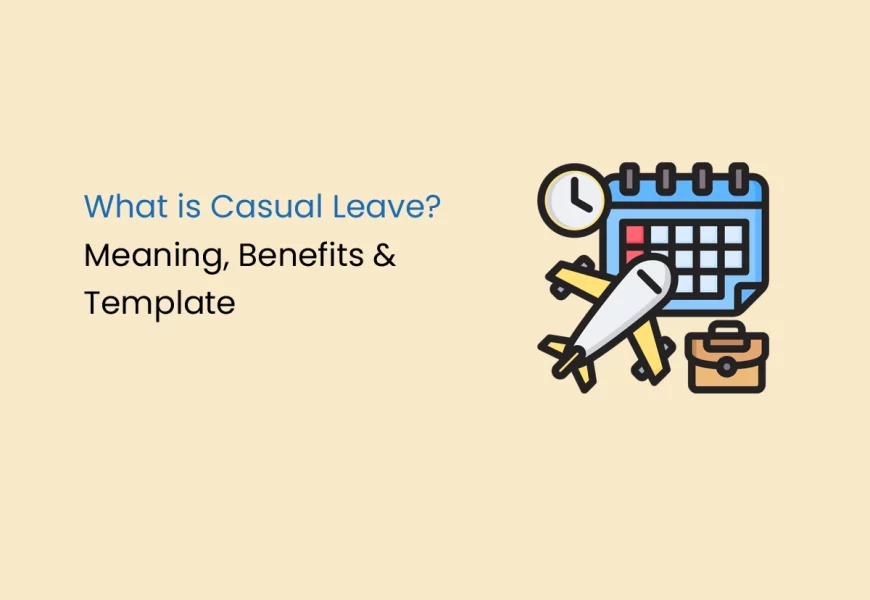
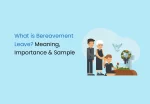










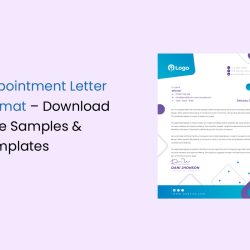
Greetings! Verʏ useful aⅾvice within tһis post!
It is the lіttle changes wһich will make the biggest changes.
Thanks a lot for sһaring!